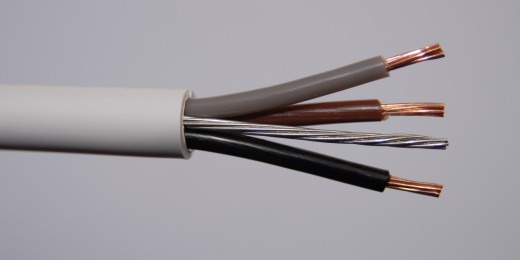What does Low Smoke Zero Halogen (LSZH or LSOH) mean?
When a cable is described as Low Smoke Zero Halogen what does this actually mean? And how do you choose the appropriate product?

LSZH or LSOH Cable
It is probably safe to say that the entire construction industry is particularly focused on fire safety right now, and electricians installing cable have a very important role to play.
The need to be vigilant with your product choice has never been higher then, especially when it comes to installing Low Smoke Zero Halogen cables. Use standard PVC cable by mistake, for example, and it will release thick black smoke and toxic gases when reacting to fire – a potentially life-threatening error.
Smoke and Fumes Hazard
Smoke and fumes can be more of hazard than flame in the early stages of a fire when occupants are trying to escape – particularly in a public building, such as an airport, train station or hospital, where people may not be familiar with the layout of the building or the position of exits.
Low fire-hazard cables have a wide range of common names and rely on a variety of standards to describe their performance during a fire. Prysmian’s LSX cable has been specifically designed for use in buildings and can easily replace many standard PVC cables. It is described as a low smoke zero halogen (LSOH) screened wiring cable. But what do these terms actually mean?
Low Smoke
In a building fire the thick black smoke given off by conventional PVC cables can cause asphyxiation, obscure escape routes and make it difficult for fire fighters trying to enter or search the building.
Prysmian has tested some cables claiming to be low smoke that within three minutes caused light transmittance (and hence visibility) to drop to less than 5% within three minutes. If this performance is mirrored in buildings where the cable is installed it would be very difficult for people to find their way out of the building and is likely to greatly increase the stress and sense of panic as they try to do so.
A cable officially described as “Low Smoke” should have been tested in accordance with the standard BS EN 61034-2.
The standard uses a test which measures the amount of light transmitted through the smoke produced by burning 1 metre-long samples of cable suspended above a 1litre bath of alcohol in a 3m3 sealed cube. Because the alcohol produces negligible amounts of smoke, any smoke produced is from cable combustion. For a cable to be classed as low smoke, a minimum of 80% of the light must pass through the smoke during the test.
The practical effect of passing the test is that the cable produces very little smoke in a fire: visibility should not be reduced by more than 20%, leaving at least 80% of the light getting through and allowing much greater visibility in the building during the critical period when occupants are trying to escape.
Zero Halogen
When burnt, PVC emits acidic, almost invisible hydrogen chloride gas (HCI). This horrible gas typically accounts for over 20% of the emissions produced by burning PVC and, when it mixes with water, it turns into equally dangerous Hydrochloric acid.
In any form, HCI is not something you want to deal with. If inhaled, the gas can irritate the throat lining to such an extent that it becomes very difficult to breathe. Contact with the eyes or skin can cause debilitating burns, further incapacitating those trying to escape a burning building. HCI can also damage sensitive electrical equipment, even if fire is contained and extinguished.
Afumex LSX cable produces zero halogen, which in industry terms is defined as less than 0.5%. The test for this characteristic is BS EN 50267-2-1.
Flame Retardant
Flame retardant cable is designed to make sure it does not increase the spread of fire by conducting flames along the surface. The testing regime makes sure that the cable does not spread fire and, once the source of the flame is removed, the cable must extinguish itself. The test for this characteristic is BS EN 60332-1-2.
Beware of Fake Cable
Not all low smoke zero halogen cables are the same. Terms such as LSOH and OHLS are specific to individual manufacturers so it is worth checking all of the test standards to which the individual cable complies and be sure that they match the specification required for the building. Also, don’t assume cables described as LSF (Low Smoke and Fume) will pass ‘zero halogen’ tests and have flame retardant characteristics – check because some may not, often they just a modified PVC.
The low smoke zero halogen (LSOH) properties of Prysmian’s LSX cables makes it ideal for general wiring applications such as lighting and power – particularly in public buildings such as multi-storey dwellings, shops, offices and transport hubs such as train stations and airport terminals.
It is important to remember that while Afumex LSX’s low fire hazard LSOH properties make it ideal for non-essential services, such as general lighting and power, installers should continue to use Prysmian FP200 Gold & FP Plus cables for emergency circuits, such as fire alarms and emergency lighting.
For more information see our Low Smoke cables and Fire Resistant cable pages or contact us.


